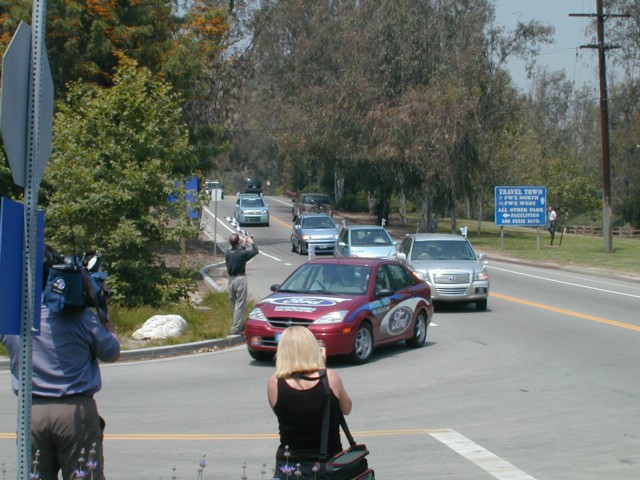
Home - AFV Events - Other AFV Events - CaFCP 2003 Rally

Last September the California Fuel Cell Partnership (CaFCP) held a fuel cell vehicle (FCV) road rally down the Pacific coast from Monterey; I reported on this hydrogen-fueled journey from the finish line in Santa Barbara. As part of their continuing effort to familiarize the public with FCVs, on 14-16 May 2003 they hit the road again for a "Rally Through the Valley," driving from Sacramento to Los Angeles through California's Central Valley. Because of smog spillover from the San Francisco area and heavy long-distance traffic "just passing through," as well as emissions from agricultural activities, this valley has some of the worst air quality in the state despite its sparse population, so it could benefit greatly from expansion of zero-emission transportation. Here are the vehicles pulling into the Los Angeles Zoo, where I met them at the end of the rally.
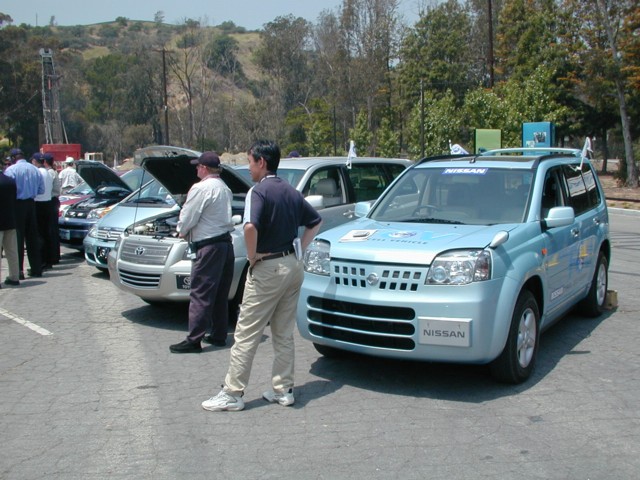
A few speakers, CaFCP participants and local officials, were on hand to make remarks in front of the row of parked vehicles; however, there was nothing like the Town Hall Meeting last fall in Santa Barbara, so I didn't get to put anybody on the spot with questions here... The vehicles were all updated versions of some of the ones I saw last year, "next year's model" so to speak; the Nissan Xterra was replaced by the X-Trail in the foreground here (this is based on a gasoline-powered model not sold in the U.S.), the Toyota Highlander was an updated version, the DaimlerChrysler F-Cell replaced the NECAR 4a (both are based on the A-Class compact, which is also not sold in the U.S.), and the Honda FCX and Ford Focus in the background were also updates.
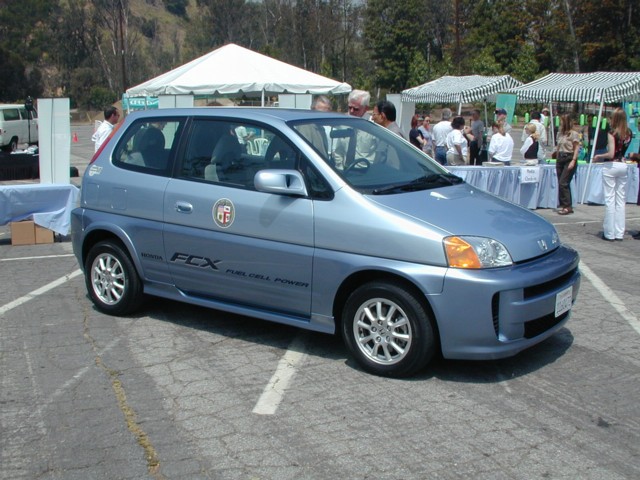
The automakers are actually starting to put their newest FCVs in (very limited!) public release; the first vehicle certified for use beyond prototype demonstrations was the Honda FCX (based on the battery-electric EV Plus), and the first ones to enter service were leased to the Los Angeles Department of Water and Power. One of these was on display there, in addition to the participants in the road rally; you'll note that there are two fuel-filler doors on the right rear quarter panel! Inevitably some joker said "yeah, one for hydrogen and one for gasoline," but the real reason is that the second door covers an electrical grounding point. The refueling connectors for compressed hydrogen (which powers all of these vehicles, though other FCVs run on liquefied hydrogen, or hydrogen "re-formed" from methanol or even gasoline) are identical to the connectors I've used for a decade to refuel my van with compressed natural gas (CNG), one of which is pictured on the front page of this website. However, hydrogen is much easier to ignite than natural gas, and so in current refueling procedures a grounding strap must be attached to the vehicle during refueling to prevent any possibility of a spark. Other vehicles conceal the attachment point for the grounding strap inside, but Honda decided that they didn't want to ask their customers to leave the hatchback open during refueling, so they mounted theirs next to the fuel inlet. I'd expect that a revised gas connector that incorporates firm grounding will become the standard for future public refueling stations, since I doubt that it will be safe to rely on average drivers to connect a separate grounding strap for each and every refueling.
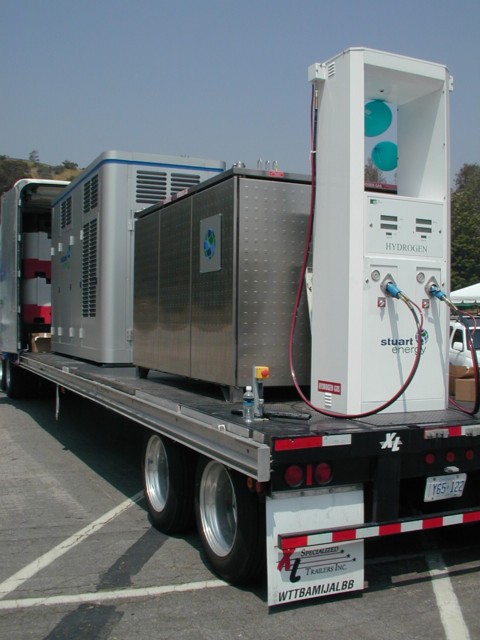
Also on display was this trailer-mounted refueling station from Stuart Energy, the Mobile Hydrogen Energy Station. This is designed to connect to an electrical power source and generate hydrogen by electrolyzing water; depending on configuration, it can then use the hydrogen to generate electricity at another time (for example, storing solar electricity for use at night, or cheap off-peak utility electric power for use during peak periods) or it can dispense it from the vehicle refueling station shown here. This is not how the vehicles refueled during the road rally (they used a tank trailer, same as last time), but equipment like this is used to refuel some of the FCVs used by the CaFCP and others in their real-world testing programs.
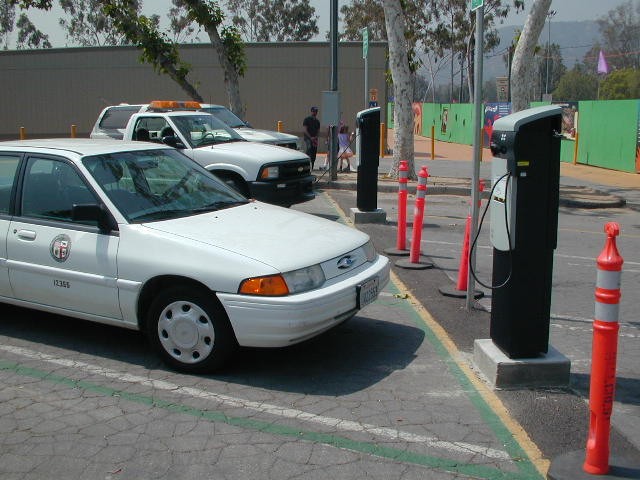
Of course, since FCVs are currently million-dollar prototypes that number in the dozens worldwide, and since there is no hydrogen refueling infrastructure apart from a few widely scattered stations for test projects like the CaFCP, it is only natural to wonder how long it will be before the vehicles start reaching the market in substantial numbers, or if they ever will at all. The photo above shows the public chargers for battery-electric vehicles (EVs) that were installed at the Zoo during the push to prepare for commercialization of EVs in California, a push that has now been all but abandoned. You'll note that there's only one EV parked here (or at the other two chargers behind the camera), a Chevy S-10 pickup owned by the Zoo. Can we look forward to a future with lots of FCVs, or will there again be a burst of effort that dissipates in a few years?
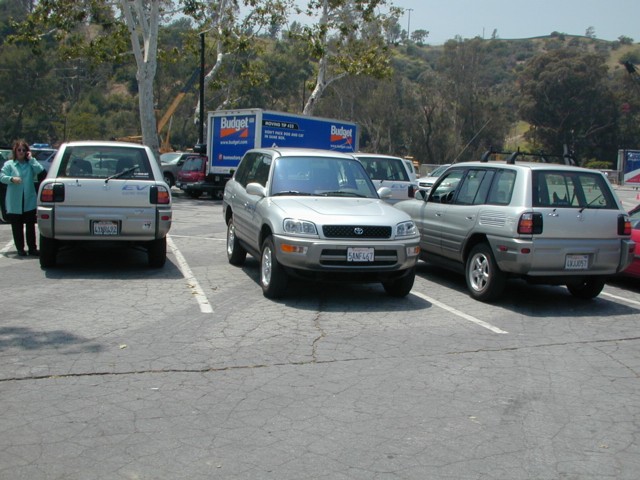
There were quite a few alternative-fueled vehicles in the parking lot, some owned by goverment agencies and some owned by private citizens who showed up: my own natural-gas van, a bi-fuel CNG Chevy Cavalier, five battery-electric Toyota RAV4-EVs (four of them pictured here), and a wide assortment of hybrid-electric cars. Standing next to the RAV4-EVs before the FCVs arrived, I was irresistably led to think "the EVs are here now, but we're still waiting for the FCVs..."
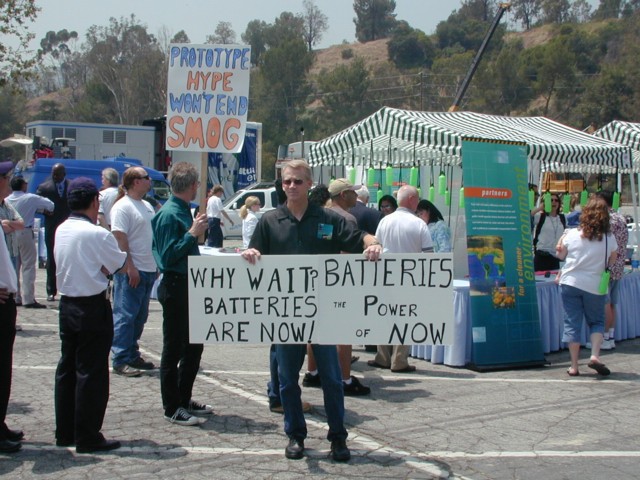
These folks thought so too! Jim Hannigan and Paul Scott arrived in their RAV4-EVs; both are former lessees of the General Motors EV1 who took advantage of the media coverage of the CaFCP event to point out that FCVs so far consist of prototypes and promises, while modern battery EVs have been on the road for years and would still be in production if automakers had made a good-faith effort to educate the public about them. Again, the question to be asked is whether in several years, when it's time to "fish or cut bait" with regard to introducing FCVs to the broader commercial market, the automakers will follow through on their current enthusiasm, or whether they will again make a token effort and then claim "the market wouldn't accept FCVs because they just weren't practical."
Rereading the above, and my report on last year's rally, I guess I sound pretty negative about the prospects. As someone who really, really wanted to buy an EV1 (they were only ever available for lease), and who has been gravely disappointed by California's failure to follow through on its enthusiasm for EVs a decade ago, it's natural for me to be mistrustful of promises. However, I do have to admit that the automakers' spokespeople, both those who make public pronouncements and those with whom I've talked personally, seem to be more enthusiastic about FCVs than all but a minority ever were about EVs, and they have committed more money to the FCV effort (I'm pretty sure, anyway) than they ever did for EVs. I think the reason is that they figure that if the refueling infrastructure gets built, consumers should be able to drive FCVs just as they currently drive gasoline vehicles: hundreds of miles at a time, with refueling taking just minutes. A basic battery EV, with a range of as little as 50-60 miles (let alone advanced ones with ranges of three times that), is plenty for the vast majority of people's daily driving, and the hours needed to recharge the batteries are not a burden because it can be done while the car is parked overnight; but the automakers were unwilling to present these arguments to the public, and they apparently think that FCVs free them from having to ask consumers to re-think their driving needs in this way.
However, there was a very big "if" in what I said above: "if the refueling infrastructure gets built..." This will be an immense, slow project, and early adopters of FCVs will find themselves in the same boat as early adopters of EVs: they will only be able to drive a limited distance, and they will have to be careful about knowing when and where to refuel. Given the automakers' failure to educate the public about the practicality of EVs for typical daily driving, can we count on them to educate the public about the practicality of FCVs in the early years? (Not to mention about their safety; the Hindenburg disaster was caused by flammable paint, not hydrogen, but that's everybody's mental image of the gas!) Time will tell; all we can do is keep the pressure on, and put our money where our mouths are when we have the chance.
 Back
to AFV Events Page
Back
to AFV Events Page Back
to Fueling Station
Back
to Fueling Station Site
Map
Site
Map Contact
Me
Contact
Me All content copyright 1998-2024 by Mark Looper, except as noted. Reuse of my copyrighted material is authorized under Creative Commons Attribution 4.0 International license (CC BY 4.0).
![]()
![]()
new 12 June 2003